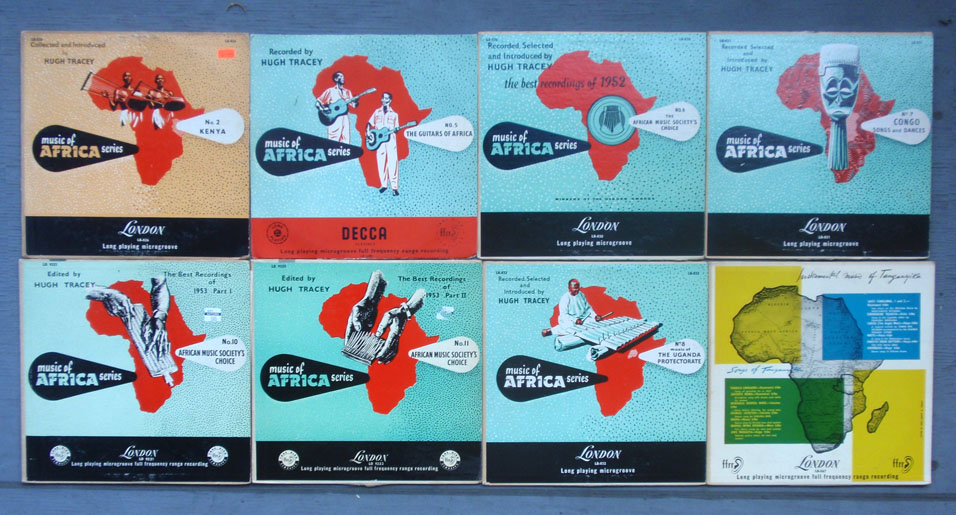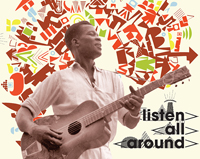
LISTEN ALL AROUND (Dust to Digital DTD52)
A new double-CD of 47 tracks recorded by Hugh Tracey is one of the mind-blowing discoveries that thrills fans of African roots music, like your reporter. Of course there are a few duplications from already reissued CDs, but the consistently outstanding quality of the music, and informative liner notes by Alex Perullo, make this worth every penny, especially given the durable book-format packaging from Dust to Digital. The subtitle is "1950s popular music from the Congo, Tanganyika, Zanzibar and Kenya." Hugh Tracey made many trips from his base in South Africa to record in the field, streets and social clubs, taking along his wife Peggy, Douglas Rex, a sound engineer, and two drivers, one a Swazi speaker the other who spoke Ndau. To help finance his travels he deliberately sought commercial acts that he knew Gallo Records could market, but also looked for good musicians in any genre to capture live. The songs were not only popular in other parts of Africa but of course were covered by American folkies in the 50s and 60s so that Jean Bosco Mwenda and one or two others had a global impact. (Pete Seeger brought Jean Bosco to the Newport Folk Festival in 1969.) Like his younger French counterpart, Charles Duvelle, Tracey's earliest published records won prizes and garnered attention. My cherished Decca 10-inches proudly proclaim "The African Music Society's Best Music for 1952" (leading off with "Masanga"); the following year there were two albums issued as winners of the Osborne Award (Decca LD9221-2). The musicians Tracey recorded quite often did not want any part of traditional music with thumb pianos and zithers, but were drawn to Cuban son, American jazz and country, European ballroom and military marches -- the prime reason being that in modern dance music you got to dance close to your partner. Tracey's first sortie in 1950 took him to Southern Rhodesia (now Zimbabwe), Nyasaland (Malawi), Tanganyika (Tanzania), Zanzibar, Uganda and Mozambique. He made over 1000 recordings and then edited and archived them. With funding from the Ford Foundation, he issued a series of 210 [sic!] LP records called The Sound of Africa between 1958 and 1963, and provided sets to 60 academic libraries. Three commercial companies, Gallo and Tropik (South Africa), and Decca (London), repackaged some of the material. The Jimmy Rogers praise song by Kipsigis girls, "Chemirocha," is here, and Jean Bosco with "Mwenda tulikwenda," and you probably have or have heard "Mama Josefina" by Patrice Ilunga and Victor Misomba, with their two guitars in open tuning accompanied by a tapped bottle. Otherwise there is little duplication with the excellent series on Sharp Wood that even includes The Very Best of Hugh Tracey and Origins of Guitar Music in Southern Congo and Northern Zambia. Perullo has found interesting parallels to Ghanaian Highlife (a restrained Coast Social Orchestra, trying to stay laid back as they romp through a cover of "Rolling Ball") and a cover of "Lamento Esclavo" by Rico's Creole Band (GV26), done here by Dar Es Salaam Jazz band. The ECO African Band gives us "Doa jeupe," a "Peanut Vendor" cover on kazoo (though not identified as such) from 1952. There are three cuts from Salum Seliman's Brass Band -- I swear the chorus to "Shukurani (give thanks)" is Woody Guthrie's "This land is your land," but Alex Perullo only says it was a popular East African song. The last cut by Ombiza Charles, "Tulale Ngonga Imelia (The Time Has Come to Sleep)" is another gem, and I thought it might be on one of the Sharp Wood issues, where I only found two other songs by him, so clearly there's more gold in those archives. The sequencing is didactic without being pedantic, in fact the flow of the music is fantastic. Tracey was not patronizing, he appreciated good music and sought out outstanding performers. Yet he personally found some of the town music tiresome with its emphasis on sex n drugs and rock n roll, but he knew that was what Gallo wanted and lamented that they were not as interested in high quality folk music. This set presents a broad spectrum of musical styles and was culled from a larger selection made by ILAM archivist Elijah Madiba who also dug through files and found photos and notes that were thought lost. One major problem is the liner notes were printed before they finalized the track sequence so there is confusion about a few of the songs. Nevertheless, it's a wonderful reach into the history of the music and is as fresh now as it was 70 years ago.
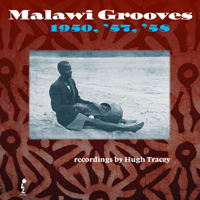
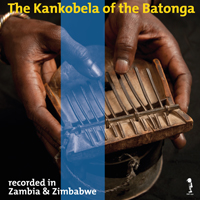
MALAWI GROOVES 1950, '57, '58 (Sharp Wood SWP051)
THE KANKOBELA OF THE BATONGA (Sharp Wood SWP05o)
One cannot understate the importance of Hugh Tracey to African music. He knew back in the 1950s that the music was evolving and many styles were in danger of being lost, but he also delighted in hearing what fresh ideas performers brought to the traditional music of their homeland. His series of albums are the cornerstone of any serious African music library. Two dozen have been restored to us in expanded form by SWP Records. Originally they appeared in many formats and different configurations from LPs to radio transcript acetates. SWP have revisited the archives and found unissued tracks to expand our understanding and enjoyment of the many wonderful kinds of music recorded by Tracey. Michael Baird of SWP spent 8 years going through those archives, listening to everything. Tracey's dedication and determination still has not been matched by later ethnomusicologists, who now jet about the continent looking for old vinyl or, in the rare case of Michael Baird still go into the bush looking for musicians in the wild to record in their natural habitat. Tracey's achievement was even more impressive when you realize that he took electricity along with him to run his recording gear. This meant a convoy of jeeps and trucks, one to carry gasoline and a generator, and when he had set up his reel-to-reel deck and microphones, the generator truck was parked behind an anthill to deaden the noise! From his base in South Africa he would set off across the veld in a Northerly direction and made it to Malawi, Zambia (Rhodesia), Mozambique, even Kenya, Uganda, and the Congo in his musical excursions.
Michael Baird the presiding genius behind SWP's series not only follows in Tracey's footsteps, bringing us sharply observed music (he is a drummer and so has a musician's ear) with fine discernment, he is also actively recreating the Tracey archives as recording technology improves and it becomes possible to get clearer sounds out of old vinyl or tapes. Of Malawi, Baird says, "Despite Madonna's adoptive meanderings, Malawi is still not fashionable." For Malawi Grooves, the vinyl issue, Baird has revisited two albums in his series: Southern and Central Malawi (SWP 013) and Northern and Central Malawi (SWP014) which were field recordings made in the 1950s on three trips by Tracey and his crew. Eight of the 15 tracks feature the bangwe board or raft zither, a 7-string instrument, there are also a tuned drum ensemble, a magical xylophone duet, a big band of kazoos and a capella singing by both men and women, for variety. The board zither has a wooden sounding board, the "raft" model sits on a bed of papyrus reeds so gives a different sound. The strings buzz and hum so it seems appropriate that the remastering was done by someone with the curious name hEuzzz. One of the performers has lost or broken a string, while Afredi Phiri has tuned his into a dissonant key that gives his piece a "twilight zone" quality that I find entrancing. This is nicely juxtaposed with a driving piece in a more familiar tuning, with the lyrics, "Money is the devil." The magical xylophone duet I mentioned is one of Hugh Tracey's greatest hits, in my opinion. It is "the Cry of the Hornbill" by Lonesi Chewane and Joni Hetara. I think they are both playing the same instrument, a wooden clack in the bass resembles the call of the title bird.
The Kankobela of the Batonga is another vinyl reissue drawn from two previous CDs recorded in Zambia and Zimbabwe in 1996 and 2008. Like Tracey, Baird made several trips to ensure he found the best exponents of the style: here thumb piano players who perform on this small portable device that is ideal for carrying about and amusing yourself. The rhythmic patterns set up by the performers are mesmerizing and the resonators rattle adding a layer of percussive friction to their playing. In some cultures bits of metal are wrapped around the tines to buzz, but here there is a spider-web membrane stretched over the sound hole which creates a buzz.
CONGO GUITARS 1952 & 1957
RECORDINGS BY HUGH TRACEY (Sharp Wood Productions SWP045)
I saw this on vinyl at a local record store and noticed it was mostly compiled from 3 Sharp Wood CDs so decided to pass on it, but I thought I should write it up anyway. I was the last person to give up vinyl (though a lot of the music I love never came out on CD), but I have finally converted all my African LPs to digital files, and now I discover I was right all along: vinyl is better. Hugh Tracey first encountered the Katanga sound -- a rich guitar sound based on traditional likembe thumb-piano riffs -- performed by the Luba people in the mining towns of Southeastern Congo in the 1950s. It had a worldwide impact at the time and influenced people as diverse as Pete Seeger and the young Franco. The album kicks off with "Masengu" by Patrice Ilunga and Victor Misomba. There are two guitars and bottle percussion and the vocals are in a mix of Swahili, Kiluba and Kanyok, a typical mining camp mix of dialects and languages: the singer is broke and depressed, all the women are back home and he just wants to get stoned! Another bluesy song from the mining camps, "Mangaay," adds basket rattles as the singers drunkenly boast about killing their neighbors. Again we get a dancing interplay of two guitars, courtesy of Chiband and Kazeng. Patrice Ilunga and Victor Misomba return with "Mama Josefina," which is the lead cut on the superb Origins of Guitar Music CD (Sharp Wood SWP017). A third track by the duo, "Antoinette wa Kolwezi," has not been previously reissued on Sharp Wood (but can be found on the Kaleidophone LP that sounds like a lop-sided score, Musical Instruments 6. Guitars 1, issued in Washington DC in 1972. Another previously un-reissued track, "Mudima zenzele," by Anatole Kaseba can be heard here, on the website of the South African Music Archive Project (but taken from a scratched 78). Other tracks are drawn from Origins of Guitar Music, as well as The Very Best of Hugh Tracey (SWP034), which to my delight grouped the 1952 Jean Bosco Mwenda recordings at the end. Bosco was busking under the town clock in Jadotville when Tracey encountered him one Sunday morning in February 1952 and captured his act on tape. I would venture that this recording is as important to African music as the Robert Johnson sessions to American music. Furthermore the set was almost lost, but had been preserved on a radio transcription of one of Tracey's broadcasts. Two of the songs were included on the African Music Society's LP Best Music for 1952, which I have on 10" LP from London records; Guitars of Africa (Vol 5 in London's series) has the original letterpress leaflet laid in, including a photo of Bosco which Tracey must have taken on the spot. The biggest star in Stanleyville at the time was Charles Ombiza, leader of Oroclos, whose guitar style had come through Angola and was called rumba (it is strummed rather than picked). He too sang about the plight of the poor workers. If you don't have Guitars of Africa, Origins of Guitar Music or The Very Best of Hugh Tracey and still have a turntable, you may want this distillation of some of the best guitar music every recorded. And if you decide to spring for the shipping from Sharp Wood, check out their other new LP Congo Traditional (SWP046), which is drawn from Hugh Tracey's bush recordings in the Belgian Congo on another musical safari. There's drums, likembes and flutes, and I've said it before: you can hear Bach fugues in the sublime Nande flute tunes which end this set.
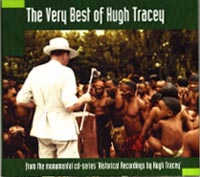
THE VERY BEST OF HUGH TRACEY (Sharp Wood SWP034)
The Sharp Wood series of reissue CDs titled "Historical Recordings by Hugh Tracey" ended last year with vols 20 (Colonial Dance Bands) and 21 (Bulawayo Jazz), but there's lots to be explored and I am constantly on the lookout to complete my set. It's a modest enough shelf but already expanded considerably over the 10-inch LPs that were issued in the fifties (with Tracey's inimitable spoken introductions), including many previously unreleased gems of roots music as well as the unexpected pleasure of the modern dance band sets that wind up the list. Sharp Wood has put out a new sampler that grazes the surface and gives one track from each album. This is welcome enough, even if you have most of the CDs, because it is well programmed, but here's the kicker: there are SIX bonus tracks of previously unreleased recordings from the famous 1952 Tracey encounter with Jean Bosco Mwenda. This is the cornerstone of modern African guitar music and anyone with any interest in soukous, benga, mbaqanga, makossa, or any of the other Central African pop sounds, needs to get hold of this crucial set to hear how a genius guitarist took the likembe style of interwoven arpeggios and turned it into sublime guitar patterns. However I urge you to sit through the previous hour of musical treats and let it come to you gradually. Along the way you will hear an eerie Zulu reedpipe orchestra that is followed by the punk rock thrum of the nguni, also from South Africa, timbila xylophones, thumb pianos, and another of Tracey's notable guitar discoveries, George Sibanda, giving us his classic "Guabi guabi." I find myself singing along to "easy weechy lay banana..." And then the big bomber: the song I consider Tracey's single most outstanding recording, "Chemirocha," a paean to Jimmy Rogers (yes, the country singer) by some Kenyan girls. The song is haunting but made more so by Tracey's introduction on the LP record (not included on the CD): "The mysterious singer and dancer Chemirocha has been turned into a local god Pan -- a faun -- half man, half antelope. He is urged by the girls to do the leaping dance, familiar to all Kipsigis, so energetically that he will jump clear out of his clothes... Who could resist such an offer?" Tracey concludes. The charm of the spoken introductions is they make each record like a radio show with real educational value.
Hugh Tracey (1903-77) was an English farmer in South Africa who couldn't understand why no one was interested in native music or traditions and set out to document it. His archive constitutes the collective musical memory of half the continent. He had great taste and superb skill with the simple recording equipment he used. The Bosco material is particularly important because two songs, "Masanga" and "Mama na mwana," were included on the breakthrough GUITARS OF AFRICA record (Decca LF1170 1952) and one of them, "Masanga" (which I call the "Classical Gas" of Africa), was picked to lead off the African Music Society's LP BEST MUSIC FOR 1952. Consequently Pete Seeger and other American folkies learned to play it and the finger-picking style of Bosco became a test of musical prowess for young guitarists. "Mama na mwana" was included on ORIGINS OF GUITAR MUSIC (SWP015/HT09) but I was surprised that "Masanga" was omitted. It is here, in all its impeccable clockwork precision, like a Bach prelude & fugue, along with five more tracks. Producer Michael Baird points out that only two songs survived in the archive but then he came across a radio air-check tape where Tracey had played the whole session! So now we are the fortunate beneficiaries of this treasure trove of early African music.
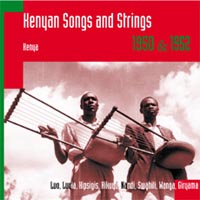
KENYAN SONGS AND STRINGS (Sharp Wood SWP030/HT19)
It's amazing the number of people I know who were deeply affected by these records: Surely the most crucial touchstones of African music for those of us first discovering it in the days before "World music" was invented as a genre. The good folk at Sharp Wood have pulled out the stops for this reissue of greatest hits of early Kenyan songs recorded by Hugh Tracey in 1950 and 1952. Some of them were released on London 10 inch LPs, as Music of Africa #2, KENYA and they are still worth having for the introductions by Tracey in his laconic tones. I keep my London 10-inch albums out of alphabetical order, alongside my Pathé-Marconis to grab if I have to run out of the building in case of an earthquake or fire. "Chemirocha" kicks it off. This is a sung homage by two shy girls to "Jimmy Rodgers," the famous American country singer, and is unearthly in its beauty. Rodgers' records were the first to be heard in this part of Kenya and the name came to mean anything strange or new. The similarity of his guitar sound to the local lyre meant that a whole legend grew around him: he was supposedly a friend of a local musician and also a faun descended from the god Pan, half man and half antelope! You really have to find the 10-inch album and hear Tracey's introduction. African harps and lyres are now almost extinct, but thanks to these recordings we can hear them today. The CD is grouped by tribes so after the 5 cuts from the Chemirocha-adoring Kipsigis we get a long set of seven Luo numbers, including one on button accordion. Michael Baird's explanation of the music is fascinating. Even for a musician it is hard to figure out where the "one" is in some of these songs and he talks about the way the Luo stagger the beat and stretch the metre, calling their strumming technique "post-punk." Only a handful of the 13 tracks on the London 10-inch are retained. I suppose Baird is telling us that good as they are, there is a lot more in the archives and he wants to give us a wider selection, rather than just repackaging the canon. This means we get some new classics like "Gevuse" by Jediah Kivali & girls & "Mulima Hale" by Salome Nolega & girls (both Luhya groups) to add to our favourites. Thank de Lawd for a musician with a good ear on the case instead of some marketing executive saying, This might sell a few units if we put a topless African girl on the cover.
Two more Tracey-hall-of-fame legends are on here: "Kiss cha moto-moto (Kiss of fire-fire)" by J. P. Odera, and another Luo classic guitar song, "Nyon Anyona (Walk proudly)" by H. Obiero. They were not on the original "Music of Africa: Kenya" album, but Tracey saved them for his ace compilation "Guitars of Africa." They wind up this set of Kenyan songs and strings which is one of the strongest compilations I have heard and I cannot recommend it highly enough.
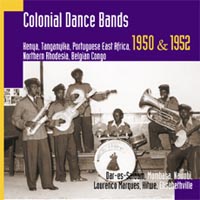
COLONIAL DANCE BANDS (Sharp Wood SWP031/HT20)
All good things come to an end, but the rediscovery of Hugh Tracey's work, culminating with these elegantly packaged dance band CDs, is a great service to music fans. Tracey's recordings of African traditional music are among the most important, not only because of their scarcity, but because of his acute ear in knowing a great musician when he met one. But here he is having fun with the short-lived era of popular jazz dance bands. The Bulawayo Sound is so important to merit its own CD {see below} and this disc is a companion, covering everything else, from Kenya to Lourenço Marques, and including Taarab and even Congolese bands.
Hugh Tracey led a remarkable life, recording & preserving African music (with a single microphone & a single-minded determination). He compiled 19 LPs in his series MUSIC OF AFRICA and a staggering 210 LPs in the SOUND OF AFRICA series. Michael Baird was born in Zambia in 1954 but moved to Holland as a young man to become a jazz drummer. He never forgot those rare early Tracey recordings that reminded him of home. A chance meeting with Andrew Tracey, son of Hugh, led him back to the International Library of African Music at Rhodes University where he discovered the original master tapes in disarray. Many had been erased or misplaced and those that survived were visibly deteriorating: every time they were played a pile of red plastic residue was left under the tape heads. (Fortunately Tracey had also cut 78s of his favourites as his own back-up copies.) So Baird set to work, without funding, to restore the sound and republish this crucial music through the Sharp Wood label in Holland. The result is a series of 21 CDs containing full length tracks, detailed liner notes, proper translations, and many songs never before released in any form. It's a monument of music and an aural delight.
The white man's vision of Africa as a paradise, from just before the Second World War up to the Mau Mau uprising of 1952, was a short-lived time of glowing nostalgia, when everything was perfectly in place, not least the waiters in starched shirts and red fezes waiting with a tray of iced drinks as fans ineffectually stirred the sticky warm air.
The colonial dance bands played Swahili rumba and songs vaguely reminiscent of covers of American and British jazz bands of the 30s & 40s. There's a sweet sadness to the Taarab numbers, and a wistful innocent nostalgia to the jagged clarinet and trumpet solos that weave in and out of these sides. Tenor sax is usually the lead, there's banjo, clarinet or trumpet, sometimes drums or claves, tuba as bass, even an accordion or guitar. And other odd things making noises: struck bottles, rattles. Chippy's Dance Band from Kitwe, Northern Rhodesia, stands out. The percussionist is so busy he sounds like he is tap-dancing. Though it's a 1952 recording it hearkens way back to the Charleston era of the 20s.

BULAWAYO JAZZ (Sharp Wood SWP032/HT21)
I don't think any of this ever appeared on LP, which makes it the "Lost Hugh Tracey tapes." Hugh Tracey spent some time in Southern Rhodesia in 1950 to 1953 recording local jazz. For once he is not fighting the mozzies and living in the bush off cold ugali porridge, but probably having a gin and tonic and calling out requests to the sophisticated band members in their dinner-jackets and bow-ties. Bulawayo Jazz developed independently from American jazz, like the Hot Club de France, and has its own unique sound, which will be familiar to anyone into more contemporary South African jazz. The instruments are banjo and percussion, bass played on tuba or trombone, and a front line of three horns, usually tenor saxes. The leading exponent of the style was August Musarurwa and he is all over this album, fronting two bands. One of them vies with the Rail Band of the Buffet Bar of the Hotel of the Station in Bamako for a distinguished long and precise name: The African Dance Band of the Cold Storage Commission of Southern Rhodesia. These guys really swing! They tear it up on "Skokiaan," and we even get to hear the great Hugh himself introduce it as "E-two, e. Two!" Gallo licensed the song, and Musarurwa had the sense to copyright it, so when it became a worldwide hit -- reaching no 17 on the American Billboard charts in 1954 -- he made some money. "Skokiaan" means moonshine, and, despite moronic lyrics added by Tom Glazer (included in the booklet) it was covered by everyone from Bill Haley to Louis Armstrong and Alma Coogan to Perez Prado -- in dozens of versions, many of which also charted in the early fifties. By the time Herb Alpert and Hugh Masakela took it on in 1978 it was a classic. Louis Armstrong sought out Musarurwa on his African tour and the two jammed. But the instrumental riffs on this album keep going in many directions. "Rhumba" is a favourite and the sound is very full because for once Tracey did not ask the drummer to move his kit away from the microphone, so you get a real sense of the thundering power of the band up close.
Because Tracey's field trips were co-sponsored by Gallo he was always looking out for material to shop to them for possible release, but this meant that he wanted straight takes of songs without a lot of improvising: the "hit it and quit" approach appropriate to a single release. Consequently the horn players had to work their ideas into the themes, which led to a lot of tangled interplay that is reminiscent of Kid Ory and the early New Orleans sound.
De Dark Brownies, who sound like a gospel choir, only appear for one song "Hlabelani ke bafana," but it is a rollicking gem: equal parts Glenn Miller and Andrews Sisters. The lead reminds me of "Boogie Woogie Bugle Boy" while the harmony does "In the mood." Another World War II favourite pops up as "Siqonda Emaquswini," which is a remake of the catchy "Colonel Bogey." The lead interplay of three saxes is truly magical. The liner notes by Michael Baird, the series producer, are thorough, and he recounts how Tracey must have asked Musarurwa if there were other good sax players in the vicinity, because Musarurwa recommended an obscure musician in Mutare, several hundred miles away. Tracey set off with his caravan of recording trucks and a week later recorded the Umtali Chipisa Band (Umtali Budget or Discount band!). As Baird points out the banjo and drum syncopation have an almost-reggae feel to them, but other tracks on here would not be amiss in the repertoire of early Ornette Coleman. There's even hints of the early sixties Sonny Rollins. This is a great discovery and we owe it to Michael Baird for his patience and determination in not only knowing this must exist, but finding it and saving it for posterity. It's a great cap to the collection of 21 Hugh Tracey CDs released by Sharp Wood.
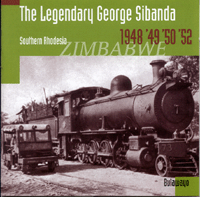
GEORGE SIBANDA
THE LEGENDARY GEORGE SIBANDA (Sharp Wood 026/HT018)
Two legends meet on this record, George Sibanda, a guitarist from Bulawayo in Zimbabwe (which was then Southern Rhodesia) and Hugh Tracey, intrepid explorer in the realms of sound. The recordings were made on an acetate cutting machine in 1948 and later on a Nagra tape recorder. Their release on 78 rpm discs in the early fifties spurrred Sibanda to stardom. There is a great variety here, from ballads to up-tempo numbers, and real crispness to the sound showing what a master Tracey was. He used a hand-held microphone, and, figuring performers wouldn't know how to play to the mike, he would move about till he found a balance between the vocals and the instrument. Now forgotten, even in his homeland, Sibanda was a chart-topper as far away as Kenya though no one there could understand his lyrics. A couple of these tracks appeared on Hugh Tracey 10 inches on Decca in the 1950s but, like other fine spirits, they improve with age, and stand out from the crop of dull music that reaches my jaded ears of late. The Duchess was surprised at how "white" Sibanda sounds and said, next I'll be listening to Arlo Guthrie! Turns out she was right: Sibanda's songs "Chuzi Mama" and "Guabi Guabi" were indeed covered by the lesser Guthrie, and by Ramblin Jack Elliot, Jim Kweskin and Taj Mahal. Sibanda's style combined country and ragtime and overlaid it with Ndebele jive. Two of his songs are undoubted hits: "Guabi Guabi" and "Dali ngiyakuthanda bah ha-ha-ha" which opens the album. Sibanda plays guitar in a finger-picking style which makes it sound like more than one instrument and his songs are whimsical: a fact that is apparent even without the translations in the booklet. There are occasional English lyrics which will have you singing along. One of his big hits, "Chuzi mama," recorded in 1948 has this lyric: "I have no worries, no sins, only that of money, Ragtime melody, plenty of money, nothing spent. When I die my money will go for the ragtime melody." Who knows where he came up with "Ragtime melody," maybe a British musical hall number, but it was eerily prophetic. Sibanda couldn't handle fame, and drank himself to death by the end of the nineteen-fifties.

FELICIANO GOMES, AURELIO KOWANO AND OTHERS
FORGOTTEN GUITARS FROM MOZAMBIQUE 1955, 56, 57
(Sharp Wood SWP 025/HT17)
Sharp Wood are reissuing some of Hugh Tracey's pioneering 1950s recordings. Not only are they digitally remastered, there is now much more material coming to our ears for the first time. This is the seventeenth volume in the series (the original ILAM series stretched to 210 LPs!). A few tracks were licensed by John Storm Roberts for his Original Music label; his AFRICAN ACOUSTIC compilation was a great taste of some of Tracey's recordings for those not lucky enough to own the 10-inches on the London label released in the mid-fifties or the Kaleidophone reissues on LP. "Kerestina" by Nacio Makanda has been anthologised before, as have a couple of others, but this is essentially a new selection from those pioneering recordings in East Africa. This is the roots of Marrabenta, akin to the way Delta Blues foreshadowed the Chicago Sound of Muddy Waters, Howlin Wolf and other Chess artists. The remixed series draws from two previous series (the populist "Music of Africa" and the academic "Sound of Africa") and features unedited selections. "Essential listening" may seem an unnecessary epithet here, but despite the simplicity -- strummed or picked guitars and vocals in alien languages -- this is magical stuff. There is a synopsis of the lyrics and notes on each song, but despite Tracey's thoroughness, very little is known about the performers, except that the two most prolific, Feliciano Gomes and Aurelio Kowano, were both cooks. Because of the movement of migrant workers to the copper mines many people were returning to their villages with guitars from South Africa, and Tracey discovered three areas rich in guitar songs: the Copperbelt itself, Katanga and Southern Mozambique. "Nyamugowelo," a humorous song about a fat foreman has a vocal echo that was produced by Gomes without electronic aids! Truly awesome singing. Kowano is a jazzier player, using a kazoo like a trumpet and altering his voice to sing like a woman.
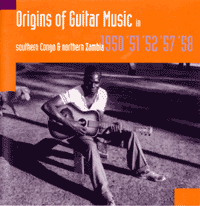
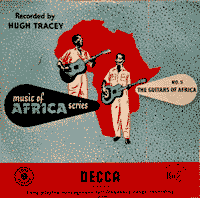

Jean Bosco Mwenda
ORIGINS OF GUITAR MUSIC IN SOUTHERN CONGO AND NORTHERN ZAMBIA (Sharp Wood 15/HT09)
I jumped on a reissue of some historic recordings by Hugh Tracey: ORIGINS OF GUITAR MUSIC IN SOUTHERN CONGO AND NORTHERN ZAMBIA, leased from the International Library of African Music at Rhodes University in South Africa, and issued by Sharp Wood Productions Records, a non-profit branch of the Stichting Foundation of Utrecht. I thought at first I was getting material I already have (on those great ten inches issued by London records in the fifties), but it turns out there's more here. In fact Tracey issued a staggering total 210 recordings in his career so what we know as the received canon is not even the tip of the iceberg. A tobacco farmer in the thirties, Tracey learned work songs alongside his field-hands and was surprised no one else was remotely interested in the music. A true African explorer, Tracey was the first to devote his life to finding and recording the music, and set off with two sound trucks and a crew of four to operate the recording equipment on his musical safaris from the Cape as far as the border of Sudan in the north. In those days, like today, the roads were non-existent in many places. He needed 240 volts of power to run the recording machines, so his noisy generator truck had to be parked behind a hut or anthill, and he also had to deal with crowds that would show up to watch him record. He didn't use mike stands but personally held the microphone rather than leave it to the inexperienced performers to play to the mike.
Four of the songs here were on AFRICAN ACOUSTIC ... FROM THE COPPERBELT (the LP) issued by John Storm Roberts, a couple of tracks are on the GUITARS OF AFRICA put out by Kaleidophone in 1972, and a couple more are on the classic 1954 MUSIC OF AFRICA 5: "The Guitars of Africa," which includes the "Classical Gas" of Africa ("Masanga" by Mwenda Jean Bosco) as well as the "Stairway to Heaven" of African guitar (Bosco's "Mama na mwana"). The latter is included on this new compilation; we'll have to wait for a further issue to collect the other tunes. Six of the songs here have never been released before, so clearly there is a wealth of material in the archives. In addition there are the scholarly notes on each track by Tracey. (On the original albums he would tell you what the song was about and add other comments in his charming British accent. The only remnant of that here is his counting in one intro.)
Many of the original tapes were destroyed in a fire in the late fifties. This is a tragedy, but may have prompted Tracey on a further visit to the same regions to rerecord the musicians he could find. But the music was evolving rapidly as people moved to urban centers, particularly to find work in the copper mines, and became exposed to Western music through the radio. Tracey points out echoes of Glenn Miller and Chet Atkins in some of the songs. The area covered by these recordings received British rather than French-run radio and, though the Congo was Belgian-controlled at the time, there's a very different feeling in the music from the rumba sound that was emerging in Kinshasa concurrently.
Two other perennial favorites from the Tracey archives are here: "Elube," by De Ndirande Pitch Crooners of Malawi and "Gwabi Gwabi" by Zimbabwean George Sibanda.
The recordings have been digitally restored. You can hear the simple percussion clearly (knife on Fanta bottle, or scraper), backing the vocals. This is one of the cornerstones of African popular music. There are 21 volumes in the new series.
